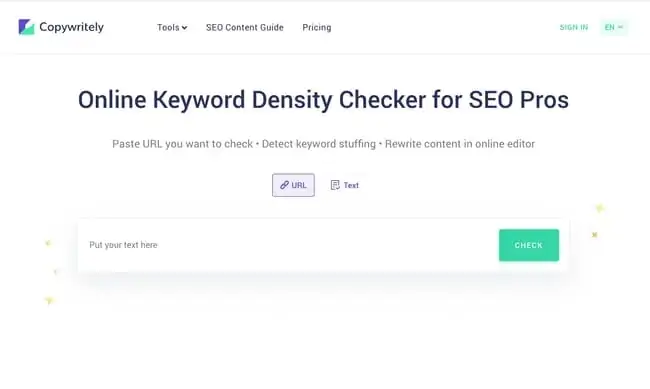In the ever-evolving landscape of Search Engine Optimization (SEO), the Guide to keyword density remains a critical concept for both beginners and seasoned professionals.
Whether you’re crafting blog posts, product descriptions, or landing pages, the right balance of keywords can make or break your SEO efforts.
This article will serve as your comprehensive guide to understanding Guide to keyword density, its importance, tools that help you analyze it, and the common pitfalls like keyword stuffing.
Table of Contents
What is Keyword Density?

Keyword density refers to the percentage of times a specific keyword appears on a web page compared to the total number of words on that page. It’s a simple calculation that gives content creators, marketers, and SEO professionals an idea of how frequently a keyword is being used.
For example, if you’re writing a blog post with 1,000 words and your target keyword appears 20 times, your keyword density would be 2%. This figure helps to quantify how “optimized” your content is for search engines, which use this data to evaluate the relevance of your web page to certain search queries.
Although keyword density was once a primary factor in SEO, search engines like Google have become much smarter over the years.
They now use complex algorithms that take into account a variety of factors such as user intent, content quality, and the natural flow of language. However, keyword density is still relevant, especially for ensuring that you’re not overusing (or underusing) specific terms.
Why Keyword Density Matters
Keyword density is important because it helps search engines understand the topic and context of your content. When a search engine crawler scans your page, it looks for keywords and phrases that align with the user’s search intent.
If your content contains relevant keywords in an appropriate density, it signals to the search engine that your page is likely a good match for the query.
Here’s why keyword density matters:
- SEO Ranking
- Relevance
- Readability and User Experience
Let’s dive deeper into why keyword density matters in each of these areas:
1. SEO Ranking
Keyword density plays a role in SEO ranking because search engines, such as Google, look for specific signals when evaluating a page’s relevance to a search query. One of these signals is how frequently a target keyword appears on the page.
If the keyword appears too little, the search engine might not perceive the page as highly relevant to the query. However, if the keyword is used too frequently, it could signal that you’re attempting to manipulate rankings through keyword stuffing (which is penalized by search engines).
A balanced keyword density ensures that the keyword is noticeable enough for search engines to understand the main topic of the page. When search engines “crawl” or analyze web pages, they look at keyword placement in critical areas such as:
- Title tag
- Meta description
- Headings (H1, H2, etc.)
- Body content
When the keyword appears naturally in these areas without overuse, search engines are more likely to consider your page relevant and rank it higher for that specific term.
2. Relevance
Relevance is the primary goal for search engines when delivering search results. Keyword density is one of the factors that helps search engines gauge how closely a piece of content matches the user’s search intent.
Imagine a user searching for “best running shoes.” If your page contains this keyword (or related variations) multiple times throughout the content, the search engine can determine that the page is likely about running shoes and therefore relevant to the user’s query.
However, if the keyword is only mentioned once or twice on a 1,000-word page, search engines might not see your content as sufficiently focused on the topic.
As a result, your page could be outranked by competitors that mention the keyword in a more appropriate density, showing that their content is more aligned with what the user is looking for.
Maintaining a balanced keyword density helps reinforce your page’s relevance to specific search terms. It’s not just about the number of times the keyword appears, but also how well it integrates with the topic you’re discussing.
3. Readability and User Experience
While keyword density impacts SEO, it also directly influences readability and user experience. Overusing keywords can make content sound unnatural and forced, leading to a poor reading experience for users.
When users land on a page filled with awkward, repetitive phrases, they are more likely to leave quickly, causing a higher bounce rate.
Here’s why that matters:
- Bounce Rate: If users leave your page immediately, it signals to search engines that your content might not be relevant or useful. High bounce rates can negatively affect your SEO rankings.
- User Retention: Content that is overly stuffed with keywords detracts from the quality of the writing. Instead of flowing naturally, the content becomes mechanical and hard to read. This poor user experience drives visitors away and reduces your chances of converting them into customers, subscribers, or loyal readers.
Maintaining an appropriate keyword density means incorporating keywords seamlessly within your content so that it reads naturally. This helps ensure that the page is informative and engaging, leading to a better experience for your audience.
Good user engagement metrics (like time spent on page, low bounce rates, and click-through rates) positively influence SEO rankings, reinforcing the importance of writing for humans first and search engines second.
In short, keyword density matters not just for technical SEO but for creating quality content that both search engines and users appreciate. By balancing keyword usage, you increase your chances of ranking well while also keeping your audience engaged.
What is Keyword Stuffing?

Keyword stuffing refers to the overuse of keywords in an attempt to manipulate a page’s ranking in search engine results. In the early days of SEO, many content creators would load a page with an excessive number of keywords, believing that this would help the page rank higher.
For example, a keyword-stuffed article about “best running shoes” might use the term unnaturally multiple times in every sentence:
“If you’re looking for the best running shoes, the best running shoes should be comfortable. These best running shoes are made from durable materials, making them the best running shoes on the market.”
This kind of repetition not only makes for poor readability but also provides a poor user experience. Search engines like Google have developed algorithms specifically to penalize pages that engage in keyword stuffing.
Therefore, keyword stuffing is now widely regarded as a “black hat” SEO technique, one that can severely damage your site’s rankings instead of improving them.
By the Numbers: The Keyword Density Formula
Calculating keyword density is straightforward. You can use a simple formula:

While this calculation is easy to perform, it’s essential to keep in mind that keyword density is just one of many factors in SEO. Ensuring your content is high-quality, well-researched, and user-friendly is far more important than obsessing over exact keyword percentages.
What is a Good Keyword Density?
There’s no universally agreed-upon “perfect” keyword density. However, SEO experts generally recommend a keyword density of around 1% to 3%.
This range ensures that your keyword appears frequently enough to signal relevance but not so often that it disrupts readability or gets flagged as keyword stuffing.
For instance, if you’re writing a 1,000-word article, using your primary keyword 10 to 30 times is typically considered safe. However, it’s important to note that search engines, especially Google, now emphasize content that reads naturally and provides value to users.
You should aim for seamless keyword integration, where the terms fit smoothly into your content rather than forcing them into every sentence.
Here’s a breakdown of factors that influence good keyword density:
- Type of Content: The optimal keyword density can vary depending on the type of content. A blog post, a product page, or a service landing page may each have different keyword density needs.
- Competitor Analysis: Look at the top-ranking pages for your target keyword. How often do they use the keyword? This can give you an idea of what’s working for that particular search term.
- Natural Language: Always prioritize writing for humans first and search engines second. Natural-sounding content is far more important than hitting an arbitrary keyword density target.
Keyword Density Tools
While calculating keyword density manually—by counting total words and keyword occurrences on every page of your website—is possible, this process becomes increasingly time-consuming and difficult as your site grows. To simplify the process, keyword density tools are available to automate and streamline this task. Some popular options include:
1. SEO Review Tools Keyword Density Checker
This free, browser-based tool allows you to check keyword density by simply entering your site’s URL or pasting your page content.
After completing a captcha, the tool provides an overview of keyword usage. Although it doesn’t offer as detailed analytics as other tools, it’s a great option for a quick check on your keyword density.

Why We Like It
The SEO Review Tools Keyword Density Checker includes a helpful color-coded alert system that highlights keywords with an unusually high density, making it easy to identify which keywords might need to be scaled back.
It also provides a breakdown of keywords based on the number of words and allows you to exclude specific phrases.
2. SEOBook Keyword Density Analyzer
Similar to the first tool, the SEOBook Keyword Density Analyzer is free, though it requires you to create an account. This tool provides basic keyword density reports, but it also allows you to compare your keyword with the top five ranked pages for the same term in Google, giving you a competitive edge by analyzing how your keyword compares to others.

Why We Like It
SEOBook’s tool allows for the inclusion of meta information and the exclusion of common “stop words” (like “a,” “the,” and “does”), which often appear in text. You can also set a minimum word length, allowing you to focus only on significant keywords that meet certain criteria.
3. Copywritely Keyword Density Checker
Copywritely’s tool highlights your top keywords by density and uses color codes to show terms that are frequently repeated. However, compared to other tools, it is more limited—it doesn’t allow you to exclude stop words or include meta descriptions. Still, it serves as a great basic tool for beginners.

Why We Like It
Copywritely’s user-friendly design makes it an excellent option for those needing a quick and simple keyword density check. The platform also offers additional services if you choose to create an account, such as error checking and content correction.
Wrap-up
When it comes to SEO, keywords are the gateway to visibility on search engines. However, the days of merely stuffing a page with keywords to achieve higher rankings are long gone.
Today, search engines focus on delivering high-quality content that serves the user’s needs. This shift emphasizes the importance of balancing keyword usage, ensuring that it enhances rather than detracts from the content.
Keyword density is just one piece of the puzzle. It remains a useful metric for ensuring that your content is adequately optimized, but it should not be the sole focus.
Content quality, user engagement, and a well-rounded SEO strategy will ultimately carry more weight in search engine rankings.
In summary, aim for a keyword density of around 1% to 3%, depending on the type of content and competition. Use keyword density tools to check your content, but always prioritize writing naturally for your audience.
After all, the ultimate goal is to provide value to users, which, in turn, will help improve your site’s search engine rankings.
By understanding keyword density and how to apply it effectively, you’ll be well on your way to mastering the balance between optimization and readability—a critical skill in today’s SEO landscape.
Keep these principles in mind as you continue to craft content, and you’ll be better equipped to unlock the full potential of your website’s SEO.






